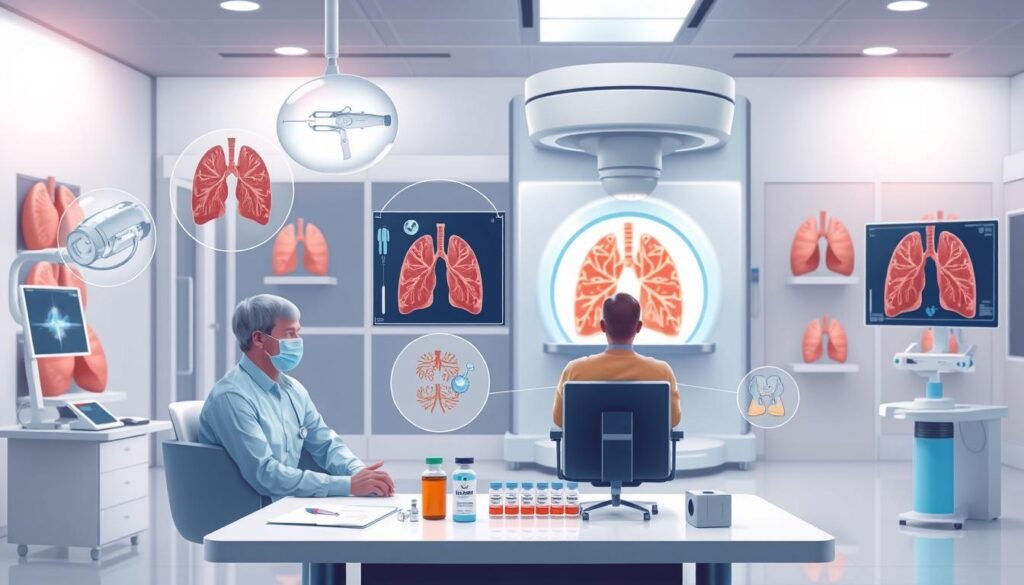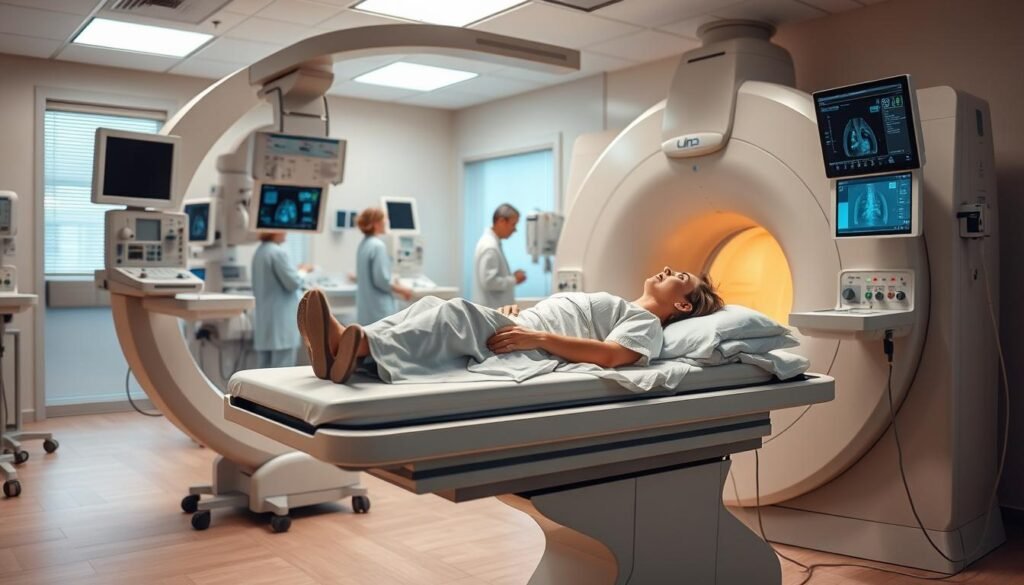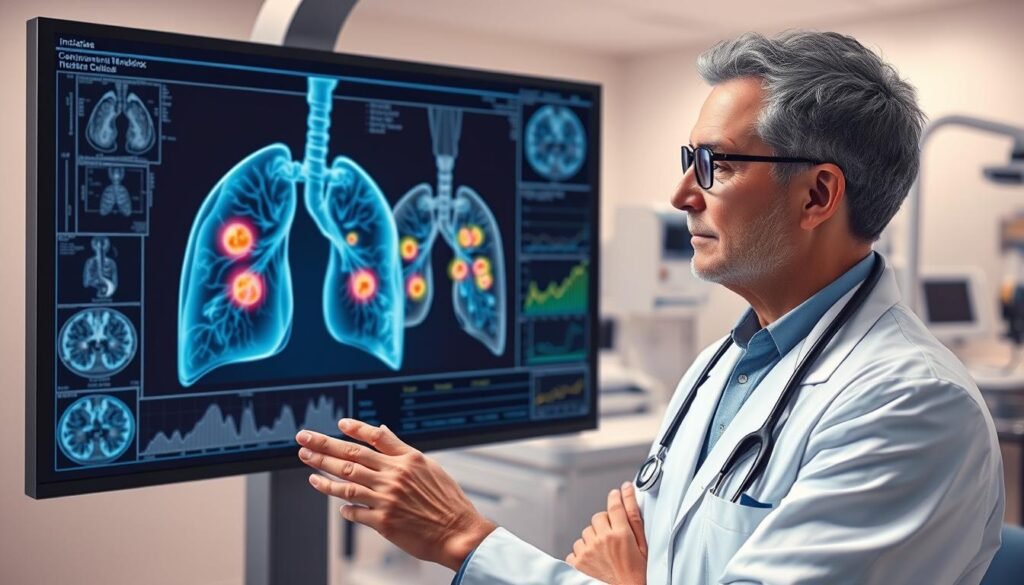Did you know lung cancer screening is suggested for those 50 and up with a history of heavy smoking? This fact highlights the need to keep an eye on lung health. When dealing with lung nodules, knowing if they are benign or malignant is key. Hence, it’s vital for patients and their loved ones to know the treatment options. This guide helps explain how to manage lung nodules. It shows why catching them early and treating them effectively is important for better health outcomes.
Key Takeaways
- Lung cancer screening is crucial for early detection, particularly in high-risk individuals.
- Lung nodules require professional assessment to determine appropriate treatment paths.
- Understanding various treatment options can lead to better management of lung cancer.
- Early detection plays a vital role in increasing the chances of successful treatment.
- Collaboration among healthcare professionals is essential for developing tailored treatment plans.
Understanding Lung Nodules
Lung nodules are small tissue masses in the lungs. They’re often spotted during scans for other health issues. About half of the adults getting chest scans have them. These nodules can be as small as 3 mm or as large as over 25 mm.
Knowing the types of lung nodules helps in understanding if they’re benign or malignant. Studies show about 95% of these nodules are not cancerous. Small nodules under 6 mm usually don’t mean cancer. But if they’re 9 mm or larger, a biopsy might be needed. It’s important to watch nodules over 10 mm closely, as they might be cancer.
Smoking greatly increases the risk of lung nodules. People who’ve smoked a lot may need a special CT scan to check for nodules early. Large nodules can cause coughing, wheezing, and breathlessness by pressing on airways.
If a lung nodule is cancerous, there are several treatment options. These can include surgery, radiation, targeted therapy, and chemotherapy. Quick and accurate diagnosis is key to managing the issue well.
Common Causes of Lung Nodules
Lung nodules can come from many sources, each pointing to different health issues. Infections like pneumonia play a major role. Past infections may also leave marks behind. Diseases like sarcoidosis can cause them as well. Noncancerous growths often result in nodules too.
Our surroundings affect lung nodule development. Working in certain environments increases our risk. Smokers, both current and former, are more likely to have cancerous nodules. About half of smokers over 50 will find nodules in a chest CT scan.
It’s worth noting that many nodules are not cancerous. Yet, there’s a 40% chance they could be. Bigger nodules are usually more concerning than smaller, calcified ones. Smooth, round nodules are less likely to be cancer than irregular ones.
Understanding these causes helps doctors judge cancer risk. They can then suggest the right tests. A thorough check-up helps tell harmless conditions from serious ones. More on this process is at this link about lung nodule diagnostics.
In the end, knowing about cancer risks, like smoking and environmental hazards, lets us make better health choices.
Importance of Early Detection
Finding lung cancer early can mean less harsh treatments and better outcomes. In the U.S., lung cancer is the second most common cancer and the leading cause of cancer deaths. Every year, more than 234,500 people are diagnosed and over 125,000 die from it.
While standard chest x-rays are often not helpful, low-dose CT scans can cut death rates by up to 20% in those at high risk. The American Cancer Society recommends yearly screenings for those 50 to 80 who smoked a lot. This scan uses a bit more radiation than an x-ray but less than a regular CT scan.
The screening is quick, easy, and uses advanced CT scanners. Centers that specialize in lung cancer screenings provide the best results. Even though LDCT scans can find issues that need more tests, they don’t replace quitting smoking. Stopping smoking greatly lowers your lung cancer risk.
Screening is best for healthy people who can have treatments like surgery if cancer is found. Medicare and many insurance plans often cover lung cancer screening. This makes it easier for those at high risk to get screened. Talking to a doctor early and knowing the symptoms helps catch lung cancer early. This can greatly improve your survival chances.
Lung Cancer Nodule Treatment Options
Whether lung cancer nodules are considered benign or malignant changes treatment paths. If nodules are benign, watchful waiting is common. This means checking the nodule over time with CT scans to notice any changes.
Watchful Waiting Approach
Watchful waiting fits best for small nodules with low cancer risk. Small nodules under 6 mm rarely are cancerous. This makes constant check-ups a good choice for these patients.
Surgical Options for Malignant Nodules
When nodules are malignant, surgery is key. Options like lobectomy or pneumonectomy depend on cancer’s spread and location. Surgery, especially for non-small-cell lung cancer, often comes before chemotherapy to help recovery.
Small-cell lung cancer mainly gets treated with chemotherapy. Sometimes, radiotherapy is added if surgery isn’t possible. The treatment plan depends on the nodule’s details. For more on managing lung nodules, see this essential resource.

| Treatment Type | Description | Best For |
|---|---|---|
| Watchful Waiting | Regular monitoring and evaluation without immediate intervention. | Benign nodules |
| Lobectomy | Removal of a lobe of the lung containing the cancer. | Localized non-small-cell lung cancer |
| Pneumonectomy | Removal of an entire lung. | Advanced localized lung cancer |
| Wedge Resection | Removal of a small section of the lung. | Smaller localized tumors |
Lung Nodule Biopsy Procedures
Doctors often perform several biopsies to check lung nodules. These tests help decide if a nodule is cancerous and what treatment is needed. Knowing about the different biopsy methods, like bronchoscopy and needle biopsy, helps patients make good health choices.
Bronchoscopy
A bronchoscopy uses a small tube with a camera to look inside the airways and take lung samples. This is good for nodules in the central airways. Patients usually get sedation, so it’s more comfortable. Doctors use it to examine lung issues seen on scans and get tissue for testing.
Needle Biopsy Techniques
Needle biopsies are important for testing lung nodules. It’s a less invasive way that uses a needle guided by CT or ultrasound. The procedure takes 30 to 45 minutes while the patient is awake. It includes several types, like fine needle aspiration and core needle biopsy. Experts in this field can diagnose nodules that bronchoscopy can’t reach.
| Biopsy Type | Invasiveness | Use Cases | Risks |
|---|---|---|---|
| Bronchoscopy | Minimally invasive | Central airway nodules | Sore throat, hoarseness, cough |
| Needle Biopsy | Minimally invasive | Peripheral nodules | Pneumothorax, bleeding, infection |
| Thoracoscopic Biopsy | Invasive | Various lung nodules | Pain, infection, bleeding |
| Open Biopsy | Invasive | Large or complex nodules | Chest infections, pneumothorax |
Talking to your healthcare team is key when having a lung biopsy. It’s important to know the prep, risks, and recovery process. Being informed and guided by experts can improve your health outcome. Expert care ensures the right approach for each person. For top lung cancer doctor insights, visit: expert oncologists in lung cancer care.
Radiation Therapy for Lung Nodules
Radiation therapy is key in treating lung cancer, especially when surgery isn’t an option. Its goal is to hit cancer cells but spare the healthy ones around them. Patients have several types of radiation therapy to choose from, based on their cancer and health.
Types of Radiation Therapy
In lung cancer treatment, we see a few main kinds of radiation therapy:
- External Beam Radiation Therapy (EBRT) – This common approach focuses radiation right on the tumor.
- Stereotactic Body Radiation Therapy (SBRT) – Used mainly for early-stage lung cancers, it delivers high doses in 1 to 5 treatments.
- Brachytherapy – This method puts radioactive material close to or inside the tumor for symptom relief.
- Proton Therapy – It precisely targets tumors, ideal for complex Stage III cancers.
Indications for Radiation in Treatment
When to use radiation for lung nodules varies. Factors like tumor size, location, and patient health matter. Radiation can be used:
- Before surgery to shrink tumors.
- After surgery to kill left-behind cancer cells.
- For symptom relief in late-stage cancers, like easing pain or breathing issues.
- To stop small cell lung cancer from reaching the brain.
Side effects like fatigue and skin changes may happen but usually get better. Seeing the doctor regularly after treatment helps ensure everything is going well.

| Type of Radiation Therapy | Typical Dose Schedule | Common Side Effects |
|---|---|---|
| External Beam Radiation Therapy (EBRT) | 5 days a week for 5 to 7 weeks | Fatigue, skin irritation, cough |
| Stereotactic Body Radiation Therapy (SBRT) | 1 to 5 high-dose treatments | Fatigue, nausea |
| Brachytherapy | Dependent on tumor size | Pain at insertion site, swelling |
| Proton Therapy | Varies based on treatment plan | Fatigue, skin changes |
Knowing about these treatments and what they entail is crucial. A tailored treatment plan improves patient outcomes and life quality.
Targeted Therapy for Lung Cancer
Targeted therapy for lung cancer is a major leap forward. It uses drugs that attack specific genetic changes in cancer cells. This approach offers personalized treatment, focusing on the individual traits of each tumor. It is key to know about the drugs used in targeted therapy to see how well treatments work.
Specific Drugs and Their Effectiveness
ALK inhibitors, like alectinib and lorlatinib, are for non-small cell lung cancer with ALK gene changes, seen in about 5% of cases. These drugs directly attack tumor growth. This often leads to the tumor getting smaller and patients living longer.
EGFR inhibitors are important for certain EGFR gene mutations. They can be used after surgery to help in recovery. Treatments for the KRAS G12C mutation, found in about 12.5% of people with NSCLC, show the progress in lung cancer treatment.
Using VEGF inhibitors with chemotherapy, like Bevacizumab (Avastin), also improves treatment. This shows how combining different treatments can work better for various types of lung cancer.
Criteria for Targeted Therapy Eligibility
To get targeted therapy, you need genetic testing first. This testing helps doctors find the specific changes in your cancer. It guides them in choosing the right drugs for you. Your overall health and other health issues are also considered to make sure the treatment is safe and effective for you.
Research keeps making targeted therapy better, offering hope for lung cancer treatment. To learn more about the latest in this area, visit here.
Immunotherapy for Lung Nodules
Immunotherapy plays a key role in treating lung nodules, especially non-small cell lung cancer (NSCLC). It uses the body’s immune system to fight cancer more effectively. The goal is to activate an immune response that goes after and kills cancer cells. This approach helps patients get better.
How Immunotherapy Works
Immunotherapy for lung nodules works by targeting certain immune pathways. Drugs like Nivolumab (Opdivo), Pembrolizumab (Keytruda), and Cemiplimab (Libtayo) block PD-1 to boost the immune system’s cancer recognition. Atezolizumab (Tecentriq) and Durvalumab (Imfinzi) aim at PD-L1, impacting tumor behavior. These treatments are customized for each patient. They’re given with chemotherapy, before or after surgery in early stages, and for longer in advanced cancer.
Benefits and Risks of Immunotherapy
Immunotherapy increases survival rates and improves life quality for lung cancer patients. It often leads to tumors getting smaller or growing slower. However, it’s important to know the risks. Side effects like tiredness, skin issues, and serious autoimmune reactions can harm various organs.
Talking to doctors right away about side effects is key. Patients need to make educated choices about their treatment. It’s essential to weigh the pros and cons of immunotherapy carefully.
Lung Cancer Surgery Options
Lung cancer surgery provides treatment paths tailored to patient needs. These significantly impact recovery and long-term health. Knowing the available surgery types is key to making informed treatment choices.
Types of Lung Cancer Surgery
There are two main surgery methods for lung cancer: thoracotomy and minimally invasive surgery. Minimally invasive surgery includes techniques like video-assisted thoracoscopic surgery (VATS) and robotic-assisted surgery. These methods often mean shorter hospital stays than traditional thoracotomies.
- Lobectomy: The most common surgery for early-stage lung cancer, it removes a lung lobe.
- Bilobectomy: Removes two lung lobes.
- Pneumonectomy: Takes out the whole lung, usually when cancer is centralized.
- Wedge Resection: Cuts out a section of a lobe and nearby tissue.
- Segmentectomy: Excises a lung segment, including veins, arteries, and airways.
- Sleeve Resection: Less common, done when cancer invades a main airway.
- Lymphadenectomy: Excises nearby lymph nodes if cancer has spread.
Post-Surgery Considerations
After surgery, patients may feel groggy and in pain. This is often managed with prescribed meds. Respiratory therapy could be part of the recovery to help lung function.
Physical therapy or pulmonary rehab is important for lung strength. The hospital stay length depends on the surgery done. This highlights the need for a solid recovery plan. For more on recovery and survivorship, visit this resource.
Lung Nodule Monitoring Strategies
Monitoring lung nodules is key for patients with non-cancerous detections. They often go through many imaging tests. These tests check the nodules’ size and traits over time. Most lung nodules are benign and small, not bigger than 3 centimeters. Yet, being over 50, smoking, or having a family history of lung cancer can up the chances of cancer.
Watching lung nodules closely helps spot changes. Non-cancerous ones grow slowly, but cancerous ones might grow quickly. CT scans are vital for spotting these changes early. If a nodule grows, gets irregular edges, or shows worrying signs, more tests like biopsies or PET scans are needed.
For big or troublesome nodules, doctors might suggest removing them. Experts recommend actions based on how likely the nodule is to be cancer—low, medium, or high risk. Regular check-ups ensure patients are well-watched over their care journey.

Lung Cancer Staging and Its Impact on Treatment
Lung cancer staging plays a key role in deciding treatment plans. It covers stages one to four in non-small cell lung cancer (NSCLC). These are shown with Roman numerals – from 0 to IV. Stage 0 is called carcinoma in situ, meaning the cancer hasn’t spread beyond the lung’s surface.
Stage I is split into stages 1A and 1B, based on how big the tumor is. Stage II includes stages IIA and IIB, looking at the tumor size and if nearby lymph nodes are involved. Stage III gets more serious, with parts IIIA, IIIB, and IIIC. This is based on the size of the tumor and if lymph nodes, especially in the mediastinal area, are involved.
Stage IV is the most severe in NSCLC, showing the cancer has spread to far parts of the body. Small cell lung cancer (SCLC) is simpler, with just limited and extensive stages. Limited means cancer is still in one lung, but may have reached nearby lymph nodes. Extensive means the cancer has spread beyond the original lung or to other distant places.
It’s crucial to understand lung cancer stages to guide treatment choices. Knowing the exact stage helps doctors find the best treatment. This could mean surgery, systemic therapies, or targeted treatments, depending on the cancer’s stage and the patient’s health.
The stage of lung cancer greatly influences treatment outcomes. Early-stage diagnosis can lead to a 63% chance of survival after five years. This is much higher compared to a distant-stage diagnosis, which has only an 8% survival rate. Quick and accurate treatment planning can greatly improve a patient’s life expectancy.
Conclusion
Managing lung cancer nodules needs a customized plan for each person. Studies show that nodule prevalence ranges from 2% to 53%. Patients and doctors must work closely together.
This teamwork is key to picking the best treatment for lung nodules. It helps achieve the best results possible.
Patients gain from knowing all treatment paths, as outlined in a comprehensive summary. Options range from watching and waiting to undergoing surgery. Despite the low rate of about 1.5% for malignant nodules, quick and correct actions are vital.
Knowing the risks and following guidelines is crucial for patient care. This knowledge helps in making informed decisions.
Being up-to-date on managing lung nodules is important. It includes regular scans and talking to specialists. Knowing their treatment choices helps patients take charge of their health journey.
This approach supports their well-being. It empowers them in their care journey.